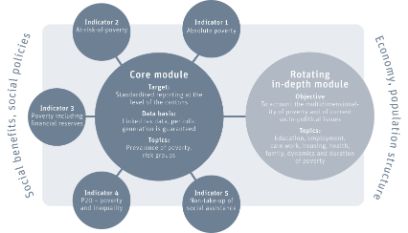- Research Project
Inequality, poverty and the welfare state
Together with its partners, BFH is setting the course for addressing issues of inequality and poverty and assessing the effectiveness of welfare state instruments in Switzerland.
Factsheet
- Lead school(s) School of Social Work
- Institute Institute for Social Security and Social Policy
- Strategic thematic field Thematic field "Caring Society"
- Funding organisation Schweizerischer Nationalfonds
- Duration (planned) 01.04.2019 - 30.09.2021
- Project management Prof. Dr. Robert Fluder
- Head of project Prof. Dr. Oliver Hümbelin
-
Project staff
Dr. Lukas Christian Schlittler
Olivier Tim Lehmann -
Partner
University of Bern Institute of Sociology, Prof. Dr. Ben Jann and Dr. Rudolf Farys
Caritas Switzerland, Marianne Hochuli, Aline Mase - Keywords Inequality, poverty, welfare state, administrative data
Situation
Globalisation, digitisation and world crises are changing poverty risk factors and influencing the levels and distribution of income globally and in Switzerland. Then there is the question of whether, under what conditions and to what extent the existing instruments of the democratic welfare state help to improve life for Switzerland’s poorest people. BFH is examining phenomena relevant to poverty reduction in several research projects. Its aim is to establish a solid foundation of facts on inequality, poverty and the workings of the welfare state in Switzerland. This will provide a basis for authorities to monitor the population’s financial situation and craft policies to combat poverty.
Objectives
We aim to answer the following questions:
- How unequal is the distribution of economic resources in Switzerland?
- How widespread is poverty?
- What are the risk factors for poverty? How are these changing in response to social upheaval?
- How effective is the welfare state in reducing inequality and poverty?
Approach
Our ongoing research projects rely on linking cantonal tax data with other administrative and survey data. We use this data to design meaningful indicators, creating a new basis for the study of economic inequality and poverty in Switzerland. This foundation addresses the shortcomings of previous approaches and opens up new possibilities for investigating old and new research questions.

Poverty monitoring – the tool to fight poverty
Statistics show that around 660,000 people are living in poverty in Switzerland, their income keeping them below the subsistence level. In order for these individuals and families to receive the support they need, systematic monitoring of the national poverty situation is crucial. The cantons play a decisive role in determining welfare policy, which is why the tools used to fight poverty vary across the country. Though some cantons produce social or poverty reports, the reporting is often sporadic and based on non-standardised indicators. Other cantons focus on the level of social benefits received and neglect that poverty should be defined more broadly. In certain cantons, the poverty situation is completely unknown. As a result, cantonal data is virtually incomparable. This fragmented field presents real challenges to authorities attempting to craft targeted poverty policies.
Poverty monitoring capabilities have improved significantly thanks to technological advances in data processing. Administrative data can now be used for poverty research. Tax data provides an important basis, which is then linked with further administrative data on housing and need-based welfare benefits. This linked data paints a detailed picture of the financial situation of the Swiss population. The administrative data – continuously generated as part of various government functions – is simple to use for the purpose of poverty monitoring. However, it is necessary to determine which methods and concepts are employed to calculate relevant indicators. To that end, BFH and Caritas Switzerland offer a helpful model. Informed by the latest in national and international research, they have developed basic principles that allow cantons to easily establish systematic poverty monitoring in order to gain important insights into the situation on the ground.
Poverty policy must keep its finger on the pulse of societal developments. A significant improvement to the patchy poverty monitoring in Switzerland could be achieved if cantons used existing databases in a uniform way. Thanks to the BFH and Caritas model, it is finally possible to establish a nationwide poverty monitoring system that takes Switzerland’s federal structure into account.
Articles and reports
Inequality and poverty in Switzerland

Attention to issues of social inequality has increased considerably in recent years. Some see such political events as BREXIT, the 2016 US presidential election and the strengthening of the right-wing populist German party AfD as the consequence of growing economic inequalities and the lack of functioning democratic means to counter them. French economist Thomas Piketty’s bestseller, Capital in the Twenty-First Century, has also increased awareness of inequality. Based on a historical analysis of fiscal data, Piketty argues that capitalism has a tendency to increase inequality. Piketty’s historical research is underpinned not least by the fact that an increase in income inequality has been observed in recent decades, particularly in the Anglo-American region. This is often seen in the context of technological change, which is leading to drastic economic and social changes.
The BFH research project – conducted in cooperation with the University of Bern – demonstrates the prevalence of income and wealth inequality in Switzerland. It also explores the question of whether technological change necessarily increases inequality.
The project shows that social science research can contribute to an understanding of these current societal developments by revealing the extent to which inequalities exist, how they change and which factors play a role in the change. New results are posted regularly on the project website.
Articles and reports
- Hümbelin, Oliver, Rudolf Farys & Tina Richard (in press): «Ungleichheit und Steuern – Steuerdatenbasierte Einblicke in die redistributiven Effekte des Schweizer Steuersystems» In: Sébastien Guex, Gisela Hürlimann, Matthieu Leimgruber (Hg.). «Steuern und Ungleichheit» Zürich: Chronos (erscheint im August 2021)
Non-use of social benefits and the limits of the welfare state
Those who fall below the subsistence level in the modern welfare state may receive social assistance to protect them from poverty. However, this right is not always exercised. For a long time, there were only estimates of the proportion of people who do not claim social assistance and other benefits from the Swiss welfare state.
BFH has developed a model that provides that information. It can be used to estimate entitlement for all Bern households by placing basic needs for subsistence, health care and housing costs alongside tax data on income and assets. The number of eligible persons determined in this way can then be compared with the social assistance statistics of the federal government.
Conclusions: A quarter of those entitled do not apply for social assistance in the canton of Bern. Significant regional differences became apparent. BFH used these differences to explore whether social norms influence the use of welfare benefits. The researchers inferred social norms from the level of urban development, language region and municipal voter shares of left- and right-wing parties. Using multiple regression analyses extended with robustness checks, BFH was able to demonstrate that social norms have an influence on individuals’ tendency to apply for social assistance.

